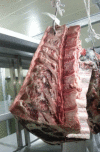Comparison of Drying Yield, Meat Quality, Oxidation Stability and Sensory Properties of Bone-in Shell Loin Cut by Different Dry-aging Conditions
- PMID: 30675105
- PMCID: PMC6335146
- DOI: 10.5851/kosfa.2018.e52
Comparison of Drying Yield, Meat Quality, Oxidation Stability and Sensory Properties of Bone-in Shell Loin Cut by Different Dry-aging Conditions
Abstract
This study aimed to investigate the drying yield, meat quality, oxidation stability and sensory properties of Hanwoo beef loin subjected to different dry-aging conditions. A total of 54 Hanwoo beef loins (bone-in, 6th-13th ribs) with fat cover at 2 d postmortem were assigned to four groups and hung in a dry-aging room at a controlled temperature (2℃-4℃), humidity (65%-85%) and air velocity (3 m/s). Four treatment conditions were tested; the respective temperature, humidity and treatment duration are as follows: T1, 2℃, 85%, 60 d; T2, 2℃, 65%, 20 d+2℃, 75%, 20 d+4℃, 85%, 20 d; T3, 2℃, 75%, 20 d+4℃, 85%, 40 d; T4, 4℃, 85%, 60 d. The drying yield, total aerobic counts and fat contents increased, whereas the moisture content, meat color (CIE L*, a*, and b*), and Warner-Bratzler shear force values decreased significantly during the aging period for all treatments (p<0.05). The cooking loss (%) did not change significantly until 40 d, and it was significantly higher in T1 and T4 than in T2 and T3 at 60 d (p<0.05). The water-holding capacity, pH and lipid oxidation [thiobarbituric acid reactive substance (TBARS) values] increased during aging (p<0.05). The sensory scores for tenderness, juiciness, flavor, and overall acceptability of dry-aged loin muscles increased as the aging period increased. T2 and T3 had significantly higher sensory scores and T1 had significantly lower scores for tenderness, juiciness, flavor, and overall acceptability at 20, 40, and 60 d for loin muscles (p<0.05).
Keywords: Hanwoo beef; dry aging; meat quality; sensory property; storage stability.
Conflict of interest statement
Conflicts of Interest The authors declare no potential conflict of interest.
Figures


Similar articles
-
Effect of Aging Time on Physicochemical Meat Quality and Sensory Property of Hanwoo Bull Beef.Korean J Food Sci Anim Resour. 2016;36(1):68-76. doi: 10.5851/kosfa.2016.36.1.68. Epub 2016 Feb 28. Korean J Food Sci Anim Resour. 2016. PMID: 27499666 Free PMC article.
-
Comparative effects of supplementing beef steers with zilpaterol hydrochloride, ractopamine hydrochloride, or no beta agonist on strip loin composition, raw and cooked color properties, shear force, and consumer assessment of steaks aged for fourteen or twenty-one days postmortem.J Anim Sci. 2014 Aug;92(8):3670-84. doi: 10.2527/jas.2014-7840. Epub 2014 May 30. J Anim Sci. 2014. PMID: 24879757 Clinical Trial.
-
Moisture enhancement and blade tenderization effects on the shear force and palatability of strip loin steaks from beef cattle fed zilpaterol hydrochloride.J Anim Sci. 2010 May;88(5):1809-16. doi: 10.2527/jas.2009-2383. Epub 2010 Jan 15. J Anim Sci. 2010. PMID: 20081069
-
Effect of Aging and Freezing Conditions on Meat Quality and Storage Stability of 1++ Grade Hanwoo Steer Beef: Implications for Shelf Life.Korean J Food Sci Anim Resour. 2017;37(3):440-448. doi: 10.5851/kosfa.2017.37.3.440. Epub 2017 Jun 30. Korean J Food Sci Anim Resour. 2017. PMID: 28747830 Free PMC article.
-
Dry aging of beef; Review.J Anim Sci Technol. 2016 May 19;58:20. doi: 10.1186/s40781-016-0101-9. eCollection 2016. J Anim Sci Technol. 2016. PMID: 27200180 Free PMC article. Review.
Cited by
-
Effects of the Aging Period and Method on the Physicochemical, Microbiological and Rheological Characteristics of Two Cuts of Charolais Beef.Foods. 2023 Jan 25;12(3):531. doi: 10.3390/foods12030531. Foods. 2023. PMID: 36766061 Free PMC article.
-
Physicochemical attributes, oxidative stability, and microbial profile of boneless sirloin and bone-in T-bone steaks from Hanwoo steer with reference to dry-aging.J Anim Sci Technol. 2021 Sep;63(5):1169-1181. doi: 10.5187/jast.2021.e95. Epub 2021 Sep 30. J Anim Sci Technol. 2021. PMID: 34796355 Free PMC article.
-
Comparison of Effects of Two Aging Methods on the Physicochemical Traits of Pork Loin.Food Sci Anim Resour. 2020 Sep;40(5):844-851. doi: 10.5851/kosfa.2020.e22. Epub 2020 Sep 1. Food Sci Anim Resour. 2020. PMID: 32968734 Free PMC article.
-
Optimization of dry-aging conditions for chicken meat using the electric field supercooling system.J Anim Sci Technol. 2024 May;66(3):603-613. doi: 10.5187/jast.2023.e65. Epub 2024 May 31. J Anim Sci Technol. 2024. PMID: 38975575 Free PMC article.
-
Changes in Physico-Chemical and Storage Properties of Dry-Aged Beef Loin Using Electric Field Refrigeration System.Foods. 2022 May 24;11(11):1539. doi: 10.3390/foods11111539. Foods. 2022. PMID: 35681287 Free PMC article.
References
-
- AOAC. Official methods of analysis. 19th ed. Association of Official Analytical Chemists; Gaithersburg, MD, USA: 2012.
-
- Ba HV, Seo HW, Kim JH, Cho SH, Kim YS, Ham JS, Park BH, Kim HW, Kim TB, Seong PN. The effects of starter culture types on the technological quality, lipid oxidation and biogenic amines in fermented sausages. LWT-Food Sci Technol. 2016;74:191–198. doi: 10.1016/j.lwt.2016.07.019. - DOI
-
- Bechtel PJ, Parrish FC. Effects of postmortem storage and temperature on muscle protein degradation: Analysis by SDS gel electrophoresis. J Food Sci. 1983;48:294–295. doi: 10.1111/j.1365-2621.1983.tb14857.x. - DOI
-
- Campbell RE, Hunt MC, Levis P, Chambers E. Dry-aging effects on palatability of beef longissimus muscle. J Food Sci. 2001;66:196–199. doi: 10.1111/j.1365-2621.2001.tb11315.x. - DOI
-
- CIE [Commission Internationale de I’Eclairage] Colorimetry, 2nd ed. Publication CIE No. 15.2. Commission Internationale de I’Eclairage; Vienna, Austria: 1986.
LinkOut - more resources
Full Text Sources

